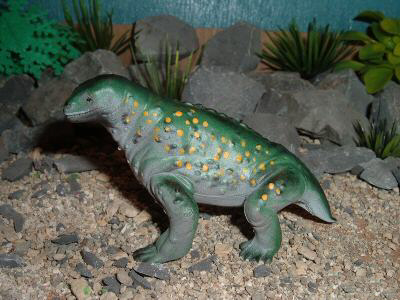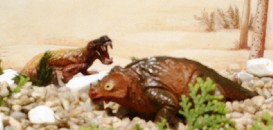Middle Permian
The best documented fauna is found in of the South African Karoo. The tapinecehaleus zone found in South Africa. Dinocephalians like Moschops Keratocephalus, diversify into a range of large-bodied foliage grazers and a few predators the anteosaurids are the large carnivores. They are gone at the end of the Tapinocephalus Zone. Parareptiles like Bradysaurus are among the plant eating fauna. Glossopteridales, seed ferns, arose in the Southern Hemisphere around the beginning of the Permian Period. These plants went on to become the dominant elements of the southern flora through the rest of the Permian but disappeared in almost all places at the end of the Permian. Glossopteris was a broad leaf, woody, seed-bearing shrub or tree, some apparently reaching 30 metres (98 ft) tall.
The Tapinocephalus Zone
 Moschops was a large 17 foot animal. The skull had a heavily
built roof that could be a sign that they engaged in head-butting like modern
sheep and deer. Possibly descended from ancestors that
were semi-aquatic Moschops was terrestrial. It has been suggested that they were partially warm blooded (endotherms). The body shape suggests they were cold blooded animals that maintained a steady body tempature because of their size (
inertial homeotherms). The northern Ulemosaurus appears to be synonymous with (although distinct at the species-level) the
Karroo Moschops.
Moschops was a large 17 foot animal. The skull had a heavily
built roof that could be a sign that they engaged in head-butting like modern
sheep and deer. Possibly descended from ancestors that
were semi-aquatic Moschops was terrestrial. It has been suggested that they were partially warm blooded (endotherms). The body shape suggests they were cold blooded animals that maintained a steady body tempature because of their size (
inertial homeotherms). The northern Ulemosaurus appears to be synonymous with (although distinct at the species-level) the
Karroo Moschops.
 Keratocephalus was a moderately sized (3 m) Tapinocephalian therapsid that lived during the middle Permian Period. Keratocephalus is characterized by a horn on the head between the eyes; it had a large skull that was 50 cm in length. the length of the snout varies greatly.
Keratocephalus was a moderately sized (3 m) Tapinocephalian therapsid that lived during the middle Permian Period. Keratocephalus is characterized by a horn on the head between the eyes; it had a large skull that was 50 cm in length. the length of the snout varies greatly.
 Bradysaurus was a parareptile about 8 feet (2.5 meters)
long. It was quadrupedal (it walked on four legs) and had thin bony armor, a
short tail, and claws on its stubby toes. Fossils have been found in the Karoo
Basin of South Africa. It can be considered an ancestral form to the later pareiasaurs. Trochosaurus (badger reptile) was a representative therocephalian predator.
Bradysaurus was a parareptile about 8 feet (2.5 meters)
long. It was quadrupedal (it walked on four legs) and had thin bony armor, a
short tail, and claws on its stubby toes. Fossils have been found in the Karoo
Basin of South Africa. It can be considered an ancestral form to the later pareiasaurs. Trochosaurus (badger reptile) was a representative therocephalian predator.
